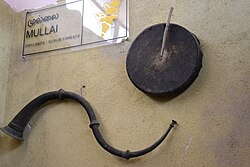
The nadaswaram is a double reed wind instrument from South India. It is used as a traditional classical instrument in Tamil Nadu, Andhra Pradesh, Telangana, Karnataka and Kerala and in the northern and eastern parts of Sri Lanka.

Baraat, also known as Varayatra, is an Indian wedding procession in which a groom travels to the wedding venue, often the bride's house, accompanied by his family members. It is rooted in North Indian traditions of Hindus.
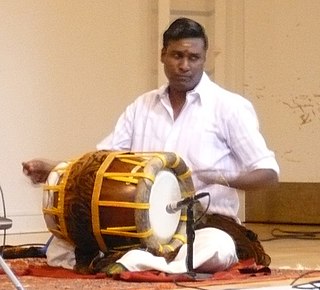
A thavil (Tamil:தவில்) or tavil is a barrel-shaped percussion instrument from Tamil Nadu. It is also widely used in other South Indian states as well as in the North and East of Sri Lanka. It is used in temple, folk and Carnatic music, often accompanying the nadaswaram. The thavil and the nadaswaram are essential components of traditional festivals and ceremonies in South India.
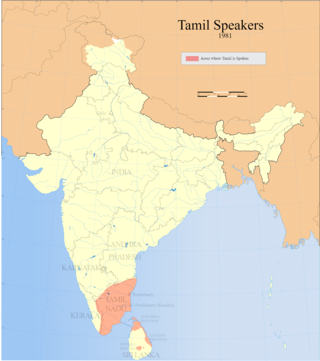
Music of Tamil Nadu has a long tradition and history going back thousands of years. Music is a very important aspect of marriage and temple festival Tamil people.

Dappankuthu is a folk dance and music genre, that is typically danced to the Gaana music genre or Kuthu Beats with an emphasis on percussion performed in the South Indian state of Tamil Nadu. It is one of several popular genres employed in film music, mainly in Tamil cinema and other South films, filmed and produced by people of Tamil culture. It is related to name Teenmaar music in Telugu states.
The term "melam" means "ensemble," as in a "musical ensemble." In Kerala, "melam" refers to a group of Maddalam (drums) and similar percussion instruments in a rhythmic performance. Those who play in melams are called 'Melakaar'. In ancient Tamilakam melams were used for all the occasions in temples, marriages, functions, and funerals. In Kerala, the most traditional of all melams is the Pandi Melam, which is generally performed outside the temple. Another melam called the Panchari Melam, which is similar to Pandi Melam, but the Panchari Melam is played inside the temple. In Malaysia and Singapore, the most common ensemble is "urumi melam", which is a group featuring the urumi drum that plays at Hindu temples and festivals.
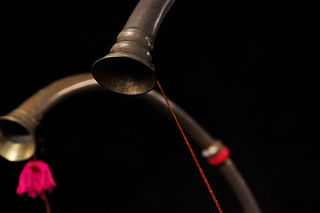
The Kombu or Kompu also known as the Kombu Pattu is a wind instrument in Tamil Nadu and Kerala. Usually played along with Panchavadyam, Pandi Melam, Panchari melam etc. This musical instrument is usually seen in south India. The instrument is like a long horn.
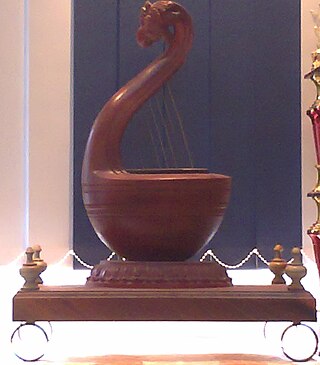
The ancient Tamil music is the historical predecessor of the Carnatic music during the Sangam period spanning from 500 BCE to 200 CE.
Kshetram vadyam is the ritual music of South India. This is the main traditional music of Kerala state. It is a percussion dominated music.

The urumi is a double-headed hourglass drum from the state of Tamil Nadu, South India. Two skin heads are attached to a single hollow, often intricately carved wooden shell. The preferred wood is jackwood, although other woods like rosewood may be used. Both left and right heads are usually made from cow hide that is stretched around a thin metal ring. The outer circumference of each head is perforated with approximately seven to eight holes. The two heads are held in tension by a continuous rope that is woven around the drum in a V-shape pattern. Additional small coils of string or metal are tied around each pair of ropes near the left head. These coils can be slide horizontally along the length of the drum, increasing or decreasing the tension between the heads as necessary. For example, during the monsoon season the drum heads will slacken so much that the instrument becomes unplayable. Using these coils drummers can easily rectify such problems.
Various dance forms are practiced in Tamil Nadu, the southernmost state of India. Tamil Nadu is the home of the Tamil people, who speak Tamil language, one of the oldest surviving languages in India. With archaeological evidence pointing to the Tamilakam region being inhabited for more than 3,800 years, Tamil culture has seen multiple influences over the years and has developed diversely. With its diverse culture, many forms of individual and group dances have their origins in the region.

Sasikumar Mahalingam is an Indian actor, film director, film producer, screenwriter and playback singer. He worked as an assistant director for director Bala in Sethu (1999), also worked for director Ameer in his first two films Mounam Pesiyadhe (2002) and Raam (2005).

Tamil culture refers to the culture of the Tamil people. The Tamils speak the Tamil language, one of the oldest languages in India with more than two thousand years of written history.

Parai also known as Thappattai or Thappu is a traditional percussion instrument from South India. It is a traditional instrument used to make announcements and played during festivals, folk dances, weddings and functions. The instrument in played predominantly by Tamil people in Tamil Nadu and other regions with significant Tamil diaspora such as Sri Lanka. There are many variants of the instrument, but generally consists of a drum made of wood, open on one side and closed with a stretched animal hide on the other side along with two wooden sticks used for beating the drum.

Tharai Thappattai is a 2016 Tamil-language musical drama film written, produced and directed by Bala. The film features M. Sasikumar and Varalaxmi Sarathkumar in the leading roles, while Ilaiyaraaja composed the film's music based on karakattam. This film also happened to be Ilaiyaraaja's 1000th film. The film began production in 2013 and released on 14 January 2016. Ilaiyaraaja won the National Film Award for Best Background Score at the 63rd National Film Awards.

Poikkaal Kuthirai Aattam or Puravi Aattam is one of the folk dances of Tamil Nadu. It is a type of dance performed with a dummy horse having a gap inside so that a person can fit into it to perform the dance.
Anthony Daasan is an Indian folk singer, who is currently working in the Tamil film industry. He is known for contributing a powerful voice to fusions of Tamil-folk, country, jazz, electronica and rock styles. Before this phase of playback singing, he worked as a travelling festival folk singer artist, collaborating with players of Nadaswaram, Thavil and Thappu, dancers and acrobats among others. He has performed with influential movie industry veterans such as Usha Uthup.
